2016 Peugeot 308 Weight
[x] Cancel search: WeightPage 5 of 398

308_en_Chap00a_sommaire_ed02-2015
Driving recommendations 146
Starting-switching off the engine
14
8
Manual parking brake
15
4
ele
ctric parking brake
15
5
Hill start assist
16
2
5-speed manual gearbox
16
3
6-speed manual gearbox
16
3
Gear ef ficiency indicator
16
4
Automatic gearbox
16
5
Dynamic pack
16
9
Stop & Start
17
0
Memorising speeds
17
3
Speed limiter
17
4
Cruise control
17
7
Active cruise control
18
0
Display of inter-vehicle time
187
emer
gency collision alert system,
emergency collision braking system
19
0
Blind spot sensors
19
5
Parking sensors
19
8
Reversing camera
20
0
Park Assist
20
1
Under-inflation detection
209 F
uel tank 21 3
Diesel misfuel prevention
21
4
Snow chains
21
6
Very cold climate screen
21
7
tow
ing a trailer
21
8
ene
rgy economy mode
21
9
Accessories
22
0
Changing a wiper blade
22
2
Fitting roof bars
22
3
Bonnet
2
26
Petrol engine
22
7
Diesel engine
22
8
Checking levels
22
9
Checks
23
3
AdBlue
® additive and SCR system
(BlueHDi Diesel) 235
W
arning triangle
24
3
temp
orary puncture
repair kit
24
4
Changing a wheel
25
0
Changing a bulb
25
6
Changing a fuse
26
6
12 V battery
27
2
to w
i n g
2
7 5
Running out of fuel (Diesel)
27
7Petrol engines
27
8
Petrol weights
28
1
Diesel engines
28
4
Diesel weights
28
8
Dimensions
29
2
Identification markings
29
5
Driving
Practical information
In the event of a breakdowntec hnical data
.
emergency or assistance 296
D
eNO
N equipment
29
8
7-inch touch screen
29
9
P
eu
ge
Ot C
onnect Sound (RD5)
36
3
Audio equipment and telematics
Alphabetical index
Contents
Page 11 of 398

9
308_en_Chap00b_vue-ensemble_ed02-2015
Maintenance - technical data
Dimensions 2 92-294
Identification markings 29 5
Running out of fuel,
Diesel (primimg pump)
27
7
Checking levels
22
9-232
-
o
il
-
br
ake fluid
-
c
oolant
-
sc
reenwash, headlamp wash fluid
-
ad
ditive (Diesel with particle filter)
Checking components
233
-234
-
b
attery
-
ai
r / passenger compartment filter
-
oi
l filter
-
pa
rticle filter (Diesel)
-
br
ake pads / discs
Changing bulbs
25
6-265
-
f
ront
- r
ear 12V battery
27
2-274
Load reduction, economy
mo
de
21
9
engin
e
compartment fuses
26
6, 270 -271
Opening the bonnet
22
6
und
er the bonnet, petrol
22
7
und
er the bonnet, Diesel
22
8
Petrol engines
27
8 -280
Diesel engines
28
4-287
AdBlue
2
35-242 Petrol weights
28
1-283
Diesel weights
28
8 -291
.
Over view
Page 132 of 398
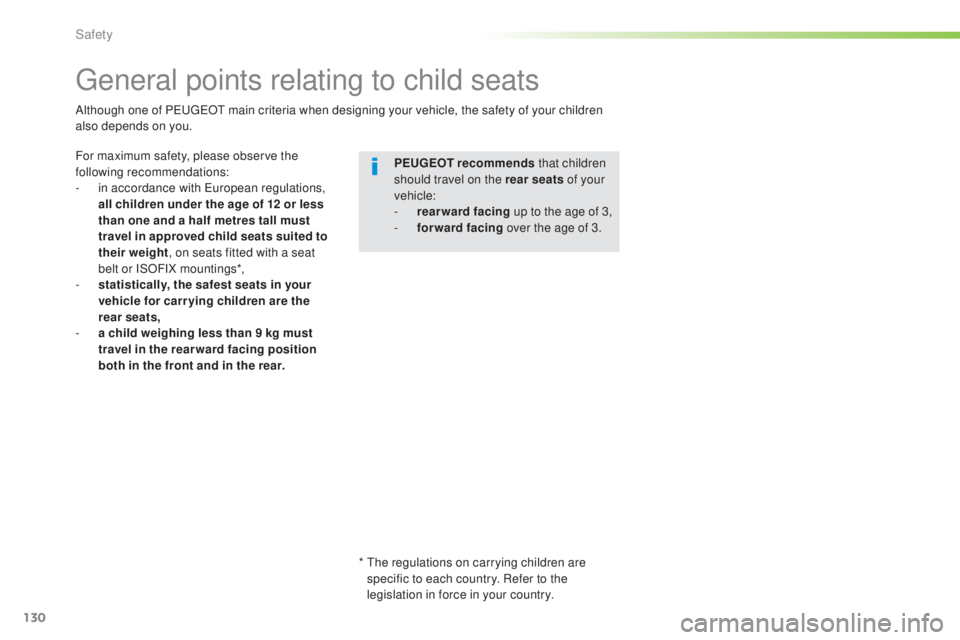
130
308_en_Chap05_securite_ed02-2015
general points relating to child seats
For maximum safety, please observe the
following recommendations:
-
in a
ccordance with
eur
opean regulations,
all children under the age of 12 or less
than one and a half metres tall must
travel in approved child seats suited to
their weight , on seats fitted with a seat
belt or ISOFIX mountings*,
-
st
atistically, the safest seats in your
vehicle for carr ying children are the
rear seats,
-
a ch
ild weighing less than 9 kg must
travel in the rear ward facing position
both in the front and in the rear. PEUGEOT recommends
that children
should travel on the rear seats of your
vehicle:
-
re
arward facing up to the age of 3,
-
for
ward facing over the age of 3.
Although one of P
eu
ge
Ot m
ain criteria when designing your vehicle, the safety of your children
also depends on you.
*
t
he r
egulations on carrying children are
specific to each country. Refer to the
legislation in force in your country.
Safety
Page 139 of 398

137
308_en_Chap05_securite_ed02-2015
Locations for child seats secured with the seat belt
Weight of the child / indicative age
Seat Less than 13 kg
(groups 0 (b) and 0+)
up to 1 ye
ar approx From 9 to 18 kg
(g r o u p 1)
From 1 to 3 years approx
From 15 to 25 kg (group 2)
From 3 to 6 years approx
From 22 to 36 kg (group 3)
From 6 to 10 years approx
Front passenger seat (c) (d)
-
wi
th height adjustment U (R)U (R)U (R)U (R)
-
wi
thout height adjustment
(straightening the backrest) U (R)
U (R)U (R)U (R)
In accordance with the
eur
opean regulation, this table indicates the options for the installation of child seats secured using the seat belt and universally
approved (a) in relation to the weight of the child and the seat in the vehicle.
Hatchback
Outer rear seats (e) UUUU
Centre rear seat (e) U (f )U (f ) XX
SW
Outer rear seats (e) UUUU
Centre rear seat (e) XXXX
5
Safety
Page 140 of 398
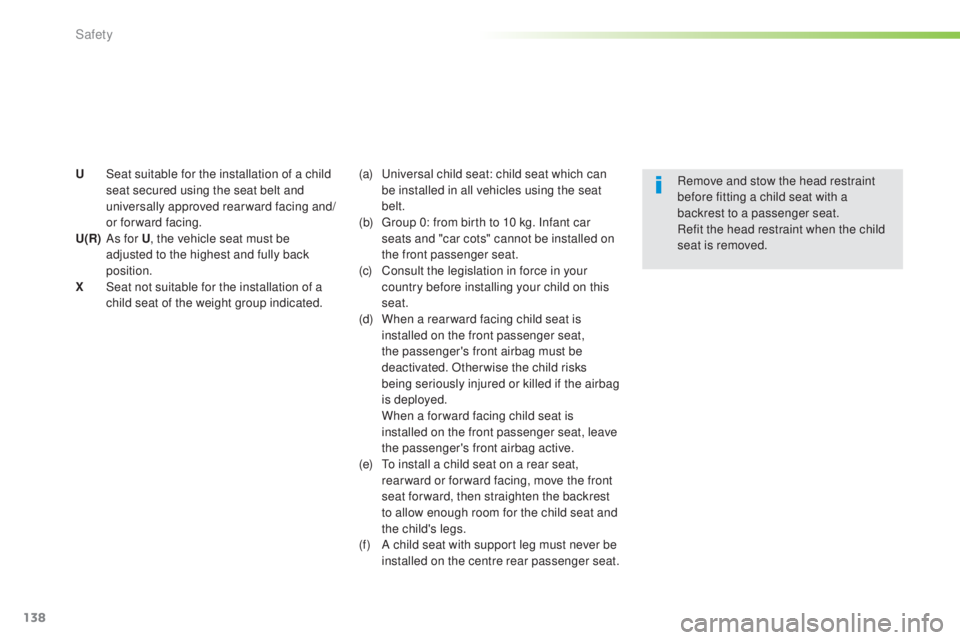
138
308_en_Chap05_securite_ed02-2015
U Seat suitable for the installation of a child
seat secured using the seat belt and
universally approved rearward facing and/
or forward facing.
U(R)
As f
or U, the vehicle seat must be
adjusted to the highest and fully back
position.
X
Se
at not suitable for the installation of a
child seat of the weight group indicated. Remove and stow the head restraint
before fitting a child seat with a
backrest to a passenger seat.
Refit the head restraint when the child
seat is removed.
(a)
uni versal child seat: child seat which can
be installed in all vehicles using the seat
belt.
(b)
g
ro
up 0: from birth to 10 kg. Infant car
seats and "car cots" cannot be installed on
the front passenger seat.
(c)
Co
nsult the legislation in force in your
country before installing your child on this
seat.
(d)
Wh
en a rear ward facing child seat is
installed on the front passenger seat,
the passenger's front airbag must be
deactivated. Otherwise the child risks
being seriously injured or killed if the airbag
is deployed.
Wh
en a for ward facing child seat is
installed on the front passenger seat, leave
the passenger's front airbag active.
(e)
t
o in
stall a child seat on a rear seat,
rear ward or for ward facing, move the front
seat for ward, then straighten the backrest
to allow enough room for the child seat and
the child's legs.
(f)
A ch
ild seat with support leg must never be
installed on the centre rear passenger seat.
Safety
Page 144 of 398
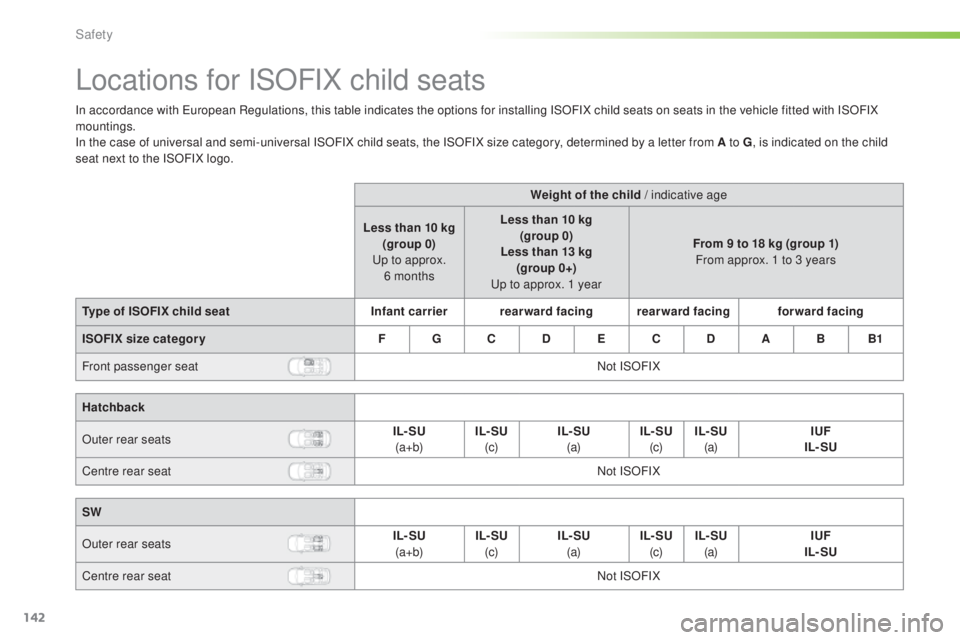
142
308_en_Chap05_securite_ed02-2015
Locations for ISOFIX child seats
In accordance with european Regulations, this table indicates the options for installing ISOFIX child seats on seats in the vehicle fitted with ISOFIX
mountings.
In the case of universal and semi-universal ISOFIX child seats, the ISOFIX size category, determined by a letter from A to G , is indicated on the child
seat next to the ISOFIX logo.
Weight of the child / indicative age
Less than 10 kg (group 0)
up
to approx.
6
m
onthsLess than 10 kg
(group 0)
Less than 13 kg (group 0+)
up to a
pprox. 1 yearFrom 9 to 18 kg (group 1)
From approx. 1 to 3 years
Type of ISOFIX child seat Infant carrierrearward facing rearward facing forward facing
ISOFIX size categor y F G C D E C D A B B1
Front passenger seat Not ISOFIX
Hatchback
Outer rear seats IL- SU
(a+b) IL- SU
(c) IL- SU
(a) IL- SU
(c) IL- SU
(a) IUF
IL- SU
Centre rear seat Not ISOFIX
SW
Outer rear seats IL- SU
(a+b) IL- SU
(c) IL- SU
(a) IL- SU
(c) IL- SU
(a) IUF
IL- SU
Centre rear seat Not ISOFIX
Safety
Page 145 of 398
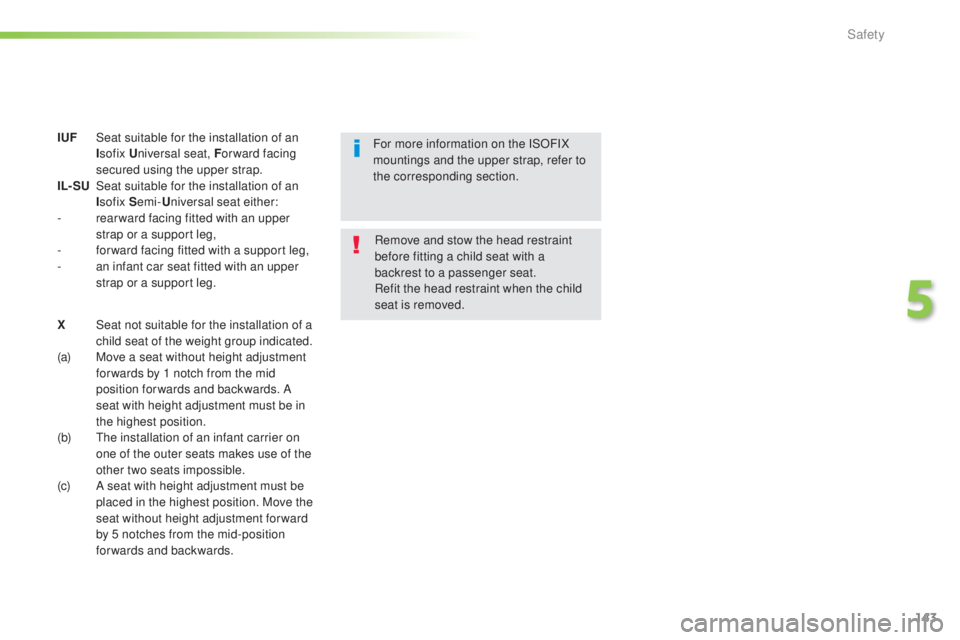
143
308_en_Chap05_securite_ed02-2015
IUF Seat suitable for the installation of an
Is
ofix Universal seat, F or ward facing
secured using the upper strap.
IL- SU
Se
at suitable for the installation of an
I sofix S emi-Universal seat either:
-
re
ar ward facing fitted with an upper
strap or a support leg,
-
fo
r ward facing fitted with a support leg,
-
an i
nfant car seat fitted with an upper
strap or a support leg. For more information on the ISOFIX
mountings and the upper strap, refer to
the corresponding section.
X
Se
at not suitable for the installation of a
child seat of the weight group indicated.
(a)
Mov
e a seat without height adjustment
for wards by 1 notch from the mid
position for wards and backwards. A
seat with height adjustment must be in
the highest position.
(b)
t
he i
nstallation of an infant carrier on
one of the outer seats makes use of the
other two seats impossible.
(c)
A se
at with height adjustment must be
placed in the highest position. Move the
seat without height adjustment forward
by 5 notches from the mid-position
forwards and backwards. Remove and stow the head restraint
before fitting a child seat with a
backrest to a passenger seat.
Refit the head restraint when the child
seat is removed.
5
Safety
Page 149 of 398
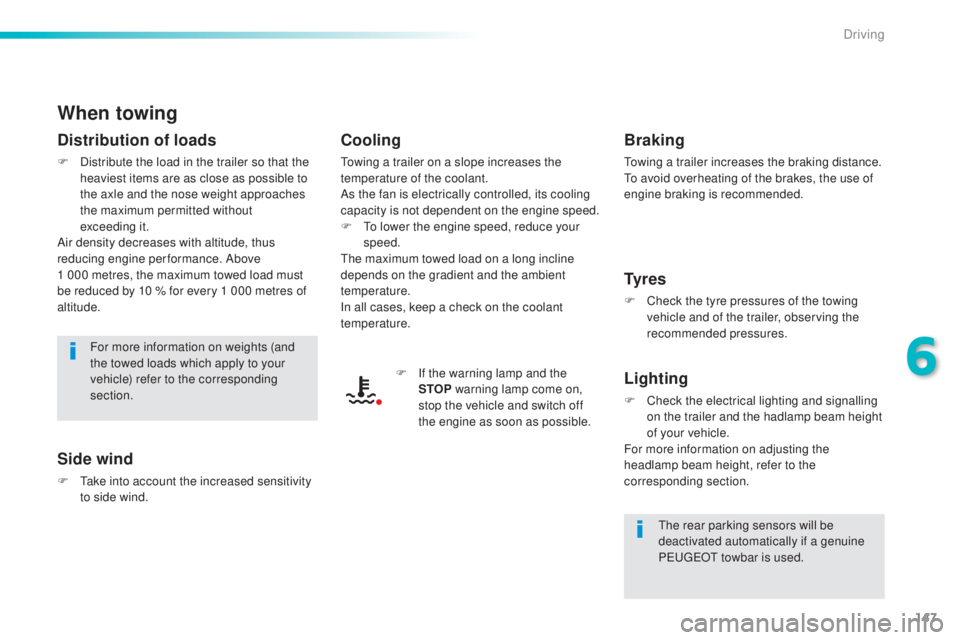
147
308_en_Chap06_conduite_ed02-2015
When towing
Distribution of loads
F Distribute the load in the trailer so that the
heaviest items are as close as possible to
the axle and the nose weight approaches
the maximum permitted without
exceeding
it
.
Air density decreases with altitude, thus
reducing engine performance. Above
1
0
00
m
etres, the maximum towed load must
be reduced by 10
% f
or every 1
0
00 metres of
altitude.
Side wind
F take into account the increased sensitivity
t o side wind.
Cooling
towing a trailer on a slope increases the
t emperature of the coolant.
As the fan is electrically controlled, its cooling
capacity is not dependent on the engine speed.
F
t
o lo
wer the engine speed, reduce your
speed.
the m
aximum towed load on a long incline
depends on the gradient and the ambient
temperature.
In all cases, keep a check on the coolant
temperature.
F
If t
he warning lamp and the
STOP warning lamp come on,
stop the vehicle and switch off
the engine as soon as possible.
Braking
towing a trailer increases the braking distance.to av oid overheating of the brakes, the use of
engine braking is recommended.
Ty r e s
F Check the tyre pressures of the towing
v ehicle and of the trailer, observing the
recommended pressures.
Lighting
F Check the electrical lighting and signalling
o n the trailer and the hadlamp beam height
of your vehicle.
For more information on adjusting the
headlamp beam height, refer to the
corresponding section.
For more information on weights (and
the towed loads which apply to your
vehicle) refer to the corresponding
section.
the r
ear parking sensors will be
deactivated automatically if a genuine
P
eu
ge
Ot t
owbar is used.
6
Driving